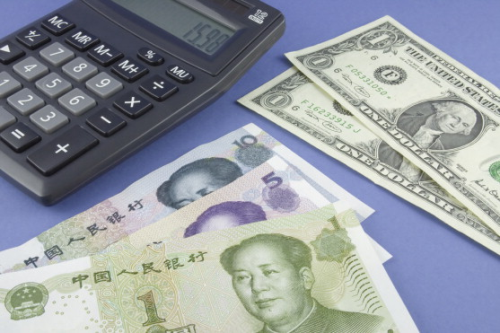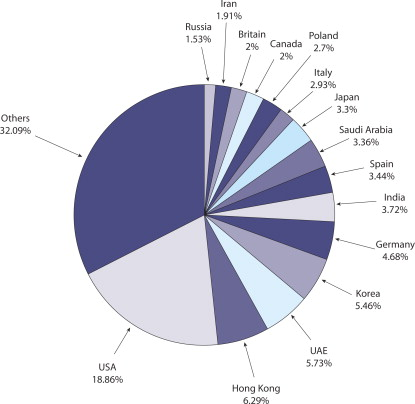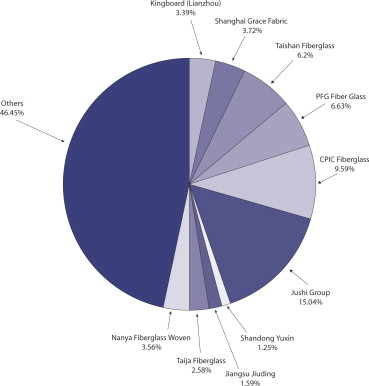


In 2005, the Chinese glass fibre industry continued to step up production. Output grew by 32.8% compared to 2004 and product sales revenue was 32.2% higher. Sales of chemical reinforcing yarn and electronic yarns grew particularly strongly. The top ten companies made a profit of about RMB1.95 billion, about 50% of the total. At the same time, as a result of rising prices for coal, power, oil and transport, costs increased and the growth rate of profit fell 38%.
During the period fibreglass reinforcements developed especially fast, including products such as chopped strand mat, continuous mat, knitted mat, and needled mat.
Import and export
Exports of the fibreglass industry are among the fastest developing in the Chinese building materials industry with an annual growth rate of 43%. According to China Customs statistics the total import and export of fibreglass products in 2005 was 757 800 tons, 25% higher than 2004. The total value was US$1.461 billion, 26.65% higher and about 9.55% of the total import and export value of China's building materials and non-metallic products.
Export volumes reached 568 800 tons, an increase of 33.4%, and the export value was US$859 million, up by 34.37%. The surplus was US$256 million. Among the exported products fibreglass yarn export value was US$291 million, 34.45% higher, and fibreglass fabric exports reached US$214 million, 23.27% higher than the year before.
About two thirds of Chinese fibreglass products are exported to the USA (20.83% in terms of export value), Europe (18.09%) and Asia (24.52%). Products sold to Hong Kong were worth 19.18% of the total export value. The major exporting areas of China are Zhejiang, Guangdong, Shanghai and Jiangsu, together accounting for 63.94% of the total fibreglass and products export value.
2005 imports reached 188 900 tons, an increase of only 5.14%. The import value was US$603 million, 17.08% higher. The main products imported were electronic yarn and fabric and fibreglass reinforcing base materials that were urgently required in the domestic market, which accounted for the fact that the growth rate of import value was much higher than that of the import amount.
Taiwan was one of the major manufacturers and consumers of electronic fabric. However its policy to close the import market and open the export market limited the entry of fibreglass product from mainland China into Taiwan. In 2005 the amount of fibreglass and related products from Taiwan was 91 500 tons and the value was US$258 million or 42.82% of the total import value. Exports to Taiwan however were only 22 400 tons and the value was US$7.4 million (0.86%) of the total export value. The 42% difference between import rate and export rate shows the huge imbalance of fibreglass trade between mainland China and Taiwan.
The important exporters to China are:
- Taiwan;
- Japan;
- South Korea;
- USA;
- Malaysia;
- Belgium;
- Hong Kong;
- Belorussia;
- Italy;
- Singapore etc.
Guangdong, Shanghai, Jiangsu and Zhejiang imported about 89.9% of the total amount and 91.49% of the total value.
The fibreglass export market still suffers from low quality fibreglass mainly made in less developed areas of the country.
Output and profit will keep on increasing in 2006 thanks to strong domestic demand and growing exports. Output in 2006 is expected to reach 1.1 million tons and profit RMB2.4 billion yuan; exports are expected to amount to 700 000 tons and the import value will be US$2 billion.
Prospects 2006-2010
The industry should remain market orientated. The focus is updating furnace technology and the promotion of product applications. Large groups and enterprises will get stronger support from the government. All efforts are to strengthen the fibreglass industry and make it follow the road of industrialisation. The objective is to raise the development level and realise sustainable development. The fibreglass industry will focus on the updating the industry's technical and quality level and enlarging product variety and applications.
By the year 2010 fibreglass output is expected to reach 1.3-1.6 million tons (with an annual growth rate of around 10–15%), 90% of which will be furnace produced. The export value is expected to be US$2 billion (with an annual growth rate of 20%) and the sales income RMB36 billion.
Demand for fibreglass will continue to grow. Demand for fibre reinforced plastics (FRP), electric insulation material and other materials will keep increasing, and engineering plastics, construction, infrastructure and environmental protection projects will also see rapid growth.
Fibreglass enterprises are being encouraged to update their techniques and equipment to meet the requirements of international standards so as to become more active and competitive in international markets. The government is encouraging domestic efforts to develop equipment and construct large manufacturing bases for important raw materials. It is also supporting the development of large groups and promoting mergers in order to cultivate enterprises that can drive the market forward and compete with international companies.
This article is adapted from a feature published in the March 2007 edition of Reinforced Plastics China, Reinforced Plastics' quarterly Chinese-language magazine.




